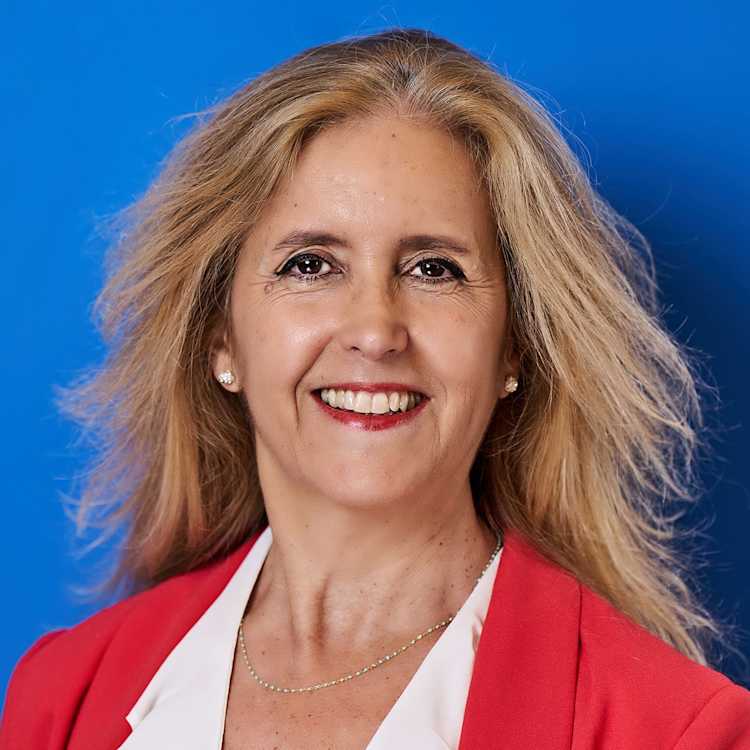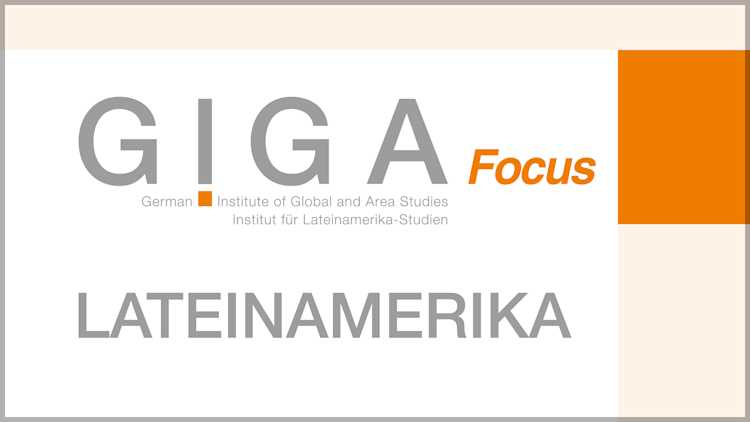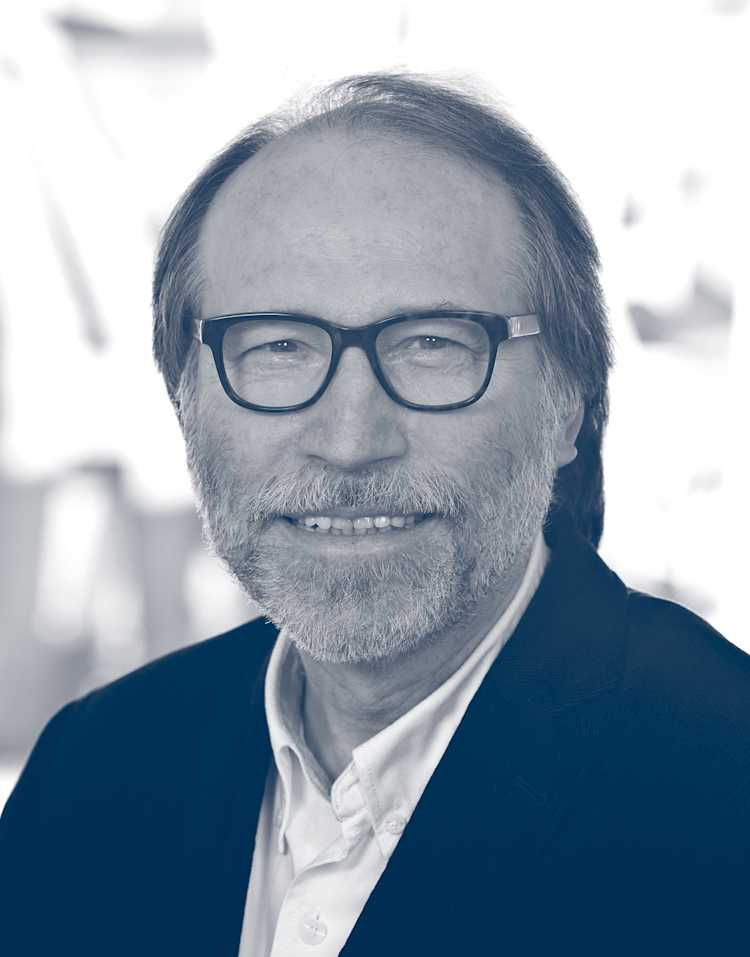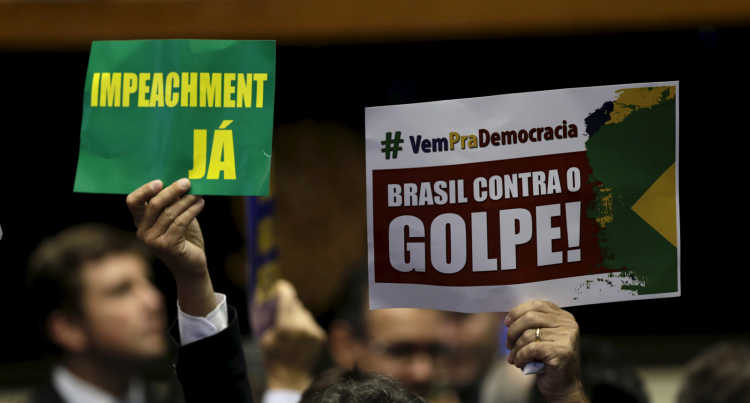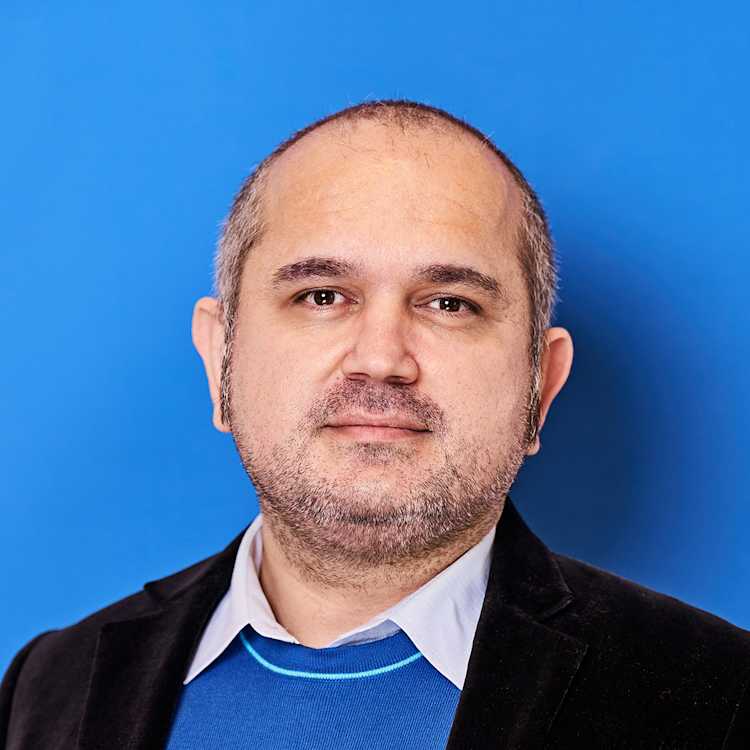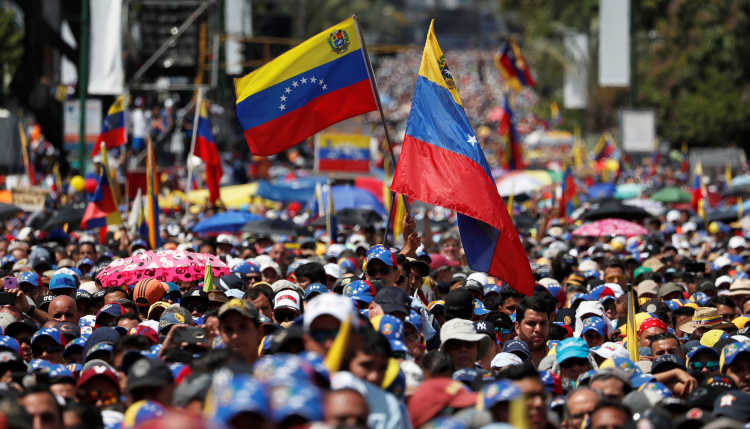- Home
- Publications
- GIGA Focus
- Government Changeover without a Majority – Latin American Presidents’ Executive Strategies
GIGA Focus Latin America
Government Changeover without a Majority – Latin American Presidents’ Executive Strategies
Number 4 | 2017 | ISSN: 1862-3573

The recently established presidents in Argentina, Brazil, and Peru are seeking to implement governmental agendas that represent a policy shift with respect to previous administrations. However, in doing so, they face political and social constraints. Executive politics – that is, the presidential approach to the design of the highest executive agencies and appointment strategies – stands out as a tool to improve presidential leeway and coordination capacity.
Since late 2015 the Latin American left has faced setbacks due to the election of President Mauricio Macri of Argentina and President Pedro Pablo Kuczynski of Peru, as well as former vice president Michel Temer’s assumption of power in Brazil after the impeachment of President Dilma Rousseff.
In Argentina and Peru these power shifts in the presidency were accompanied by minority support in Congress. In Brazil, in contrast, Temer built a large coalition in Congress, albeit within a highly polarised political and social context that threatens its cohesiveness and survival.
To face congressional oppositions, attentive publics, and organised social sectors that seek to hinder their policy goals, Latin American presidents need to use their important constitutional policymaking powers – as well as their prerogatives to appoint officials and to design the executive’s upper-level structure – wisely and strategically.
The three presidents have established smaller
institutional presidencies
than their predecessors – that is, they have reduced their core structure of close aids and supports. At the same time, they have given more power to the cabinet ministers, as well as to the cabinet coordination units, with the goal of aligning the executive with the president’s policy preferences.
Policy Implications
The constitutional powers that presidents have to conduct the policymaking process, particularly in Congress, are important governing tools, but executive politics represents an equally crucial strategy. Presidents use changes to the executive’s design and political appointments to influence the creation of policies and achieve their policy goals. These are important (although often neglected) presidential tools, particularly when presidents are dealing with reform agendas within constraining political environments.
Political Shifts in Latin America
Since 17 May, when a new corruption scandal erupted in Brazil, the instability of the current president, Michael Temer, has acquired a dramatic tone. The political context has worsened, and a decision by the top electoral court at the beginning of June was seen as the opportunity to remove the president. However, the court eventually rejected the nullification (cassação) of the Dilma-Temer ticket with a tight vote, thereby dismissing the accusations of campaign finance violations. Since then, the calls demanding Temer’s resignation have not subsided, two parties have left the governing coalition, and street protests aiming to end the presidential agenda in Congress have increased. For the time being, the president has insisted on remaining in power, but four of his five special advisors have abandoned the presidential office in the face of corruption accusations.
The latest events in Brazil involve Temer directly and may cement the end of the presidency. But he has actually governed under a cloud of scandals and dismal approval ratings since assuming power about a year ago. With an ambitious reform agenda, his government, together with recently established governments in Argentina and Peru, represented an ideological shift in the region from left-wing populism to the centre right. In effect, Vice President Temer of the Brazilian Democratic Movement Party (PMDB) assumed power at the end of August 2016, after the Brazilian Congress had impeached President Dilma Rousseff of the Partido dos Trabalhadores (PT), which had held the presidency for almost four consecutive terms since 2003. In Argentina, Mauricio Macri from the Alliance Cambiemos assumed the presidency in December 2015 and thus put an end to 12 years of rule by Néstor and Cristina Kirchner (from the Alliance Frente para la Victoria, FpV). In July 2016, Peruvian voters elected a centre-right technocrat, Pedro Pablo Kuczynski, after the five-year presidency of Ollanta Humala, a politician with a military background who admittedly only briefly carried the left-wing label, as the policies and decisions he adopted after assuming power showed continuity with the market-friendly model that has prevailed in Peru in recent decades.
Although these three presidents had campaigned for new directions in government policies prior to taking office – even Temer signalled them in the PMDB manifesto released alongside the impeachment crisis – policy shifts are a hard task for presidents who have not received a clear majority mandate. In effect, the executive power shifts in Argentina and Peru were achieved in narrow run-off elections, and were accompanied by minority support in Congress. Temer built a large legislative coalition, but the highly polarised process that led him to the presidency and, as shown above, ongoing political and economic crises have damaged his already narrow social support and are threatening the coalition’s survival. These presidents need to make choices with redistributive consequences, while surrounded by distrustful or even hostile legislative parties, bureaucracies, and voters. In the presidential systems of Latin America, the extent of change a government may be able to implement depends not only on the set of ideas coming with the new president, but also on the amount of resources he/she is able to mobilise to support these ideas.
Presidents and Presidencies
Latin American presidents enjoy significant policymaking powers in multiple policy realms, giving them a means to influence the legislative agenda – for example, the power to introduce and veto legislation – and, in many cases, the power to legislate by decrees with the force of laws. Further, presidents preside over the executive branch, and have prerogatives to appoint and dismiss thousands of different government officials. Thus, Latin American presidents are directly elected, constitutionally strong, and potentially powerful individuals who lead the policymaking process. However, in recent years the scholarly literature has called attention to the institutional – rather than the individual – dimension of the presidency. First, interesting research on cabinet politics has shown not only that presidents arrange their governments according to their own calculus, but also that such arrangements usually take into account the challenges and constraints posed by critical junctures and by the availability of political resources in Congress. Multiparty cabinets, for example, reflect a fragmented Congress and are an attempt to form a presidential legislative majority. Second, recent works (such as ours) highlight the fact that presidents do not take decisions alone, but rather count on the support of a cadre of technical assistants, trusted advisors, and government agencies operating under their direct authority (Inácio and Llanos 2015, 2016). We call these agencies, which are part of the executive branch but are not located within the executive cabinet, the institutional presidency (in the following, the IP).
Our research on Latin American cases has also highlighted the ebb and flow of the size and role of the IP. We have shown that presidents heading multiparty cabinets – typical in Brazil, for instance – are more likely to centralise decisions and governing tasks in the hands of the presidential staff. That is, under their rule the IP is expected to grow. Similarly, we have seen that the IP grows under presidents pursuing reform agendas, especially structural reforms. We assume that those presidents require the strengthening of advisory and coordination structures under their authority much more than presidents who preside over cabinets where only one party is sitting and/or who do not have ambitious reform agendas. Thus, changes to the executive structure are used strategically and add to the toolbox that presidents have to exercise their governing tasks, to improve their stance vis-à-vis other institutions and actors, and to shape the pace and fate of their policy programmes.
Constraining Political Environments
How far presidents go in the implementation of reforms depends not only on the content of their agendas, but also on the opportunities other actors have to veto them. These constraining actors can be part of either the institutional setting or the broader context where presidents act. Sometimes presidents can compensate for the lack of resources in one area with the resources available in others.
In presidential systems, a government’s minority status makes presidential success in Congress harder to achieve, but even in the case of governments with majorities in Congress, other institutional traits may also complicate the political scene. The bicameral legislatures, federative structures, and decentralised judiciaries of Argentina and Brazil provide plenty of veto opportunities for the political opposition. Midterm elections, such as those scheduled to take place in Argentina in October 2017, create pressure for short-term policy results and hinder inter-party cooperation in Congress. Even in the case of more centralised systems, such as Peru’s unitary structure and unicameral parliament, other mechanisms can potentially weaken the government – for instance, the cabinet confidence vote.
Kuczynski became the president of Peru after winning the run-off election with 50.1 per cent against Keiko Fujimori, with a lead of less than 40,000 votes (a difference of 0.24 per cent). Fujimori’s Fuerza Popular obtained two-thirds of the seats in the unicameral legislature of 130 members, while the president’s party only won 18 seats. Kuczynski then became the chief executive, but Fujimori retained the undisputed leadership of the legislature. Mauricio Macri’s presidential victory in Argentina was also narrow. Macri won 51.4 per cent of the vote in the run-off election against Scioli, the candidate of the ruling FpV, with a lead of just over 700,000 votes (a difference of 2.68 per cent). The electoral results for Congress did not favour Macri in either of the chambers. He could count on the fact that Peronism usually fragments while in opposition, but deals would be unavoidable to pass legislation, as in the Peruvian case, and blockages were hence foreseeable. In Brazil, presidents form and preside over broad coalitions to ensure governability. Michel Temer had run as the vice presidential candidate, together with Dilma Rousseff of the Workers Party (PT), in the presidential contest of 2014. Despite assuming power in the extremely polarised context that surrounded Rousseff’s impeachment, Temer built a large coalition and managed to command the most favourable situation in Congress of all three presidents, until the above-mentioned crisis erupted in May. Initially, his government coalition included 11 parties and controlled 69 per cent and 77 per cent of seats in the Chamber of Deputies and the Senate, respectively. Seven of the parties had left Rousseff’s government on the eve of the impeachment decision and had voted for her removal. Four other parties came from opposition lines. One coalition newcomer, the Brazilian Social Democracy Party (PSDB), had been defeated in the 2014 presidential run-off election and had questioned the electoral results by suing the Dilma-Temer ticket before the electoral court on grounds of economic abuse. Paradoxically, this party was a government member when the electoral court recently decided against this challenge, and Aecio Neves, its then presidential candidate, is currently facing judicial investigation himself. His PSDB party has still not left the government, but it has become increasingly critical of Temer.
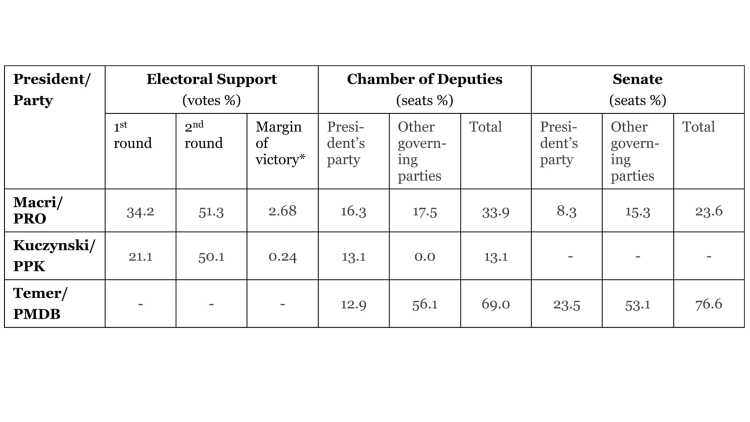
Since the policy shifts pushed by these presidents depend on large pro-reform, if not national, coalitions, the moods of other veto players matter. Governors are powerful actors in Argentina as they may exert control over congressional votes and street conflicts.
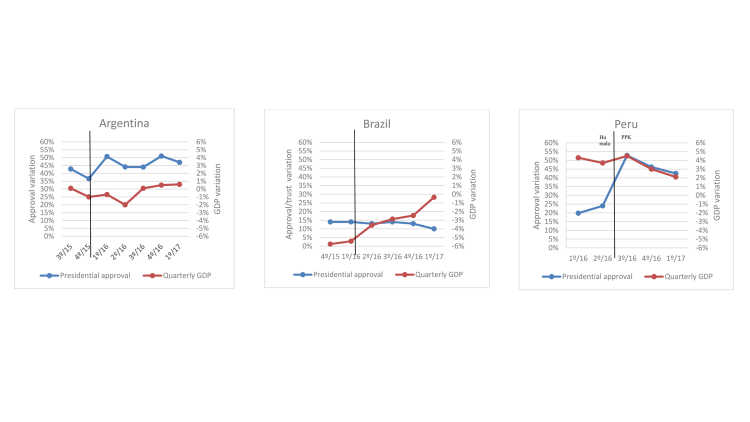
The alliance Cambiemos that took Macri to power won just five provinces out of 24, but Macri’s party (PRO) obtained the governorship of two crucial districts: the province of Buenos Aires and the autonomous city of Buenos Aires. Although financial necessity trumps political affinity and governors depend on federal government assistance, the unfavourable distribution of territorial power foreshadowed potential conflict that would require considerable negotiation effort on the part of the national executive. In Brazil, Temer’s PMDB, the most nationalised party, controlled 25 per cent of governorships when the president assumed power and obtained the largest share of mayors (19 per cent) in the municipal elections that took place in 2016. However, the fiscal reforms proposed by Temer include federative bargains related to the spending of subnational governments. Pressure for fiscal equilibrium measures coming from the federal executive may threaten the political support of the PMDB’s governors and mayors for these reforms. Anticipating this kind of federative conflict, Temer avoided attaching changes to the state and municipal pension systems to the proposed reform of the federal pension system.
Other extra-institutional factors, such as the public mood and economic indicators, can hurt presidential leverage and make it likely that more legislators will cross the floor. Particularly the two minority governments in Argentina and Peru are extremely attentive to variations in the state of public opinion. In Brazil recent polls have indicated a less negative perception around the economic situation, but Temer’s popularity had reached single digits even before the political situation worsened for the government in May.
Constraining scenarios present several challenges to presidents trying to push forward the reversal of previous policy agendas. They are particularly challenging where policy shifts focus on cuts in government expenditures, as is the case in Argentina and Brazil. In fact, it is not easy to pursue unpopular measures in the face of an attentive public and organised sectors and groups, and even more difficult if the president is unpopular. The situation demands a governmental capacity to anticipate political and institutional reactions, a sense of timing, context-sensitivity to calibrate reform bills, and the management of the executive tools to build winning coalitions.
Presidents, Cabinets, and Presidencies
In defining the executive structure, presidents seek to achieve several goals. Table 2 summarises the executive politics of the three new presidents. On the left side, it shows the ministerial composition, whether single party or multiparty. Seeking to forge a strong legislative coalition, Temer adopted a highly partisan cabinet and shared portfolio positions among party allies, nominating a few non-partisan ministers. Macri and Kuczynski also used ministerial positions to foster political support, but they did not go further than including the parties of the electoral alliance. Macri’s party predominates over coalition partners and non-partisan ministers in the cabinet. His ministers demonstrate political experience and technical expertise. More markedly, Kuczynski opted for a cabinet predominantly made up of non-partisan technocrats, although some of them have had previous political government experience.
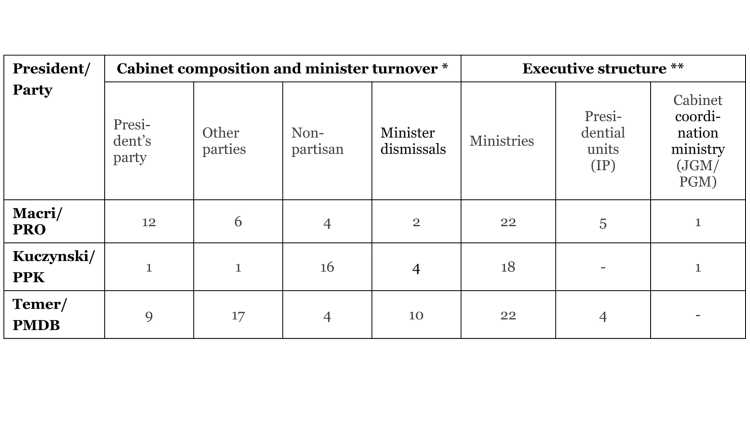
On the right side, the table reports on the executive agencies. They are grouped according to three areas: the number of ministries and the number of units located directly under the presidential authority (the IP or presidential office), and whether or not there is a cabinet coordination office. The ministries are policy units par excellence, while the units of the IP have historically had different functions. They are mainly meant to provide administrative support to the president and other core managerial functions, but have also included advisory tasks and policy implementation (Inácio 2012; Inácio and Llanos 2015). The three executives under study vary in terms of the number and type of units that compose the three areas of the executive structure. Some of these variations already begin in the constitutional text. The Argentine and Peruvian constitutions establish the Jefatura of the Ministers’ Cabinet (JGM) and the Presidency of the Council of Ministers (PGM), respectively, which are defined as institutions responsible for cabinet coordination, among other administrative and managerial tasks. Interestingly, the two institutions have been growing in both countries for some time, and their tasks have expanded even to entail policy-oriented functions.
Changes to the Executive Structure
Brazil. Of the three presidents, Temer is the one who has gone the furthest in redefining the executive in the two areas that it comprises in Brazil, the cabinet and the IP. The most remarkable move was a reduction of units in both areas, but other decisions are also noteworthy. Regarding the cabinet, given the large number of parties (11), we would have expected an increase in the number of ministries, but a large cabinet was a trait of the expansionist PT governments, and Temer wanted to signal a change in managerial orientation as well as a commitment to economic reforms. He therefore reduced the number of cabinet positions, a move which turned out to be more modest than announced, from 32 to 28 positions. In addition, the president returned to the cabinet ministries that had been centralised in the IP during the PT’s administrations. In our view, this move enhanced the value of cabinet positions for coalition partners and can be seen as a strategy to keep the oversized coalition together. It is a move similar to that of Itamar Franco (1992–1995), the other Brazilian post-impeachment president, who also reinforced the ministerial portfolios. Temer’s ministerial changes were qualitatively noteworthy and controversial, and they sometimes needed to be reversed because of the opposition they raised – as in the case of the merging of the ministries of culture and education or the closing down of the Ministry of Agrarian Development. Regarding the IP, its reduction and restructuring was no less contentious than the cabinet’s. As already noted, several of those presidential units, mostly policy units, were decentralised to ministries. The IP basically maintained advisory and coordination tasks, with the latter assigned to the Casa Civil – now in charge of the government’s public image – and the Secretariat of Government, which pursue inter-ministerial and inter-branch articulation. Only one policy unit was left as part of the presidential office: the Investment Partnership Program (PPI), which fosters infrastructure and concessions projects and is headed by PMDB’s leader, who is loyal to the president.
Argentina. There are three well-defined areas within the Argentine executive: the institutional presidency, the cabinet, and the Jefatura of the Ministers’ Cabinet. Although many structural changes have taken place in these areas over the last year, Macri has not altered longer-term tendencies: the size of the cabinet and the JGM have been growing in the last 15 years, while the IP has been simultaneously contracting. Under Macri, cabinet growth and unit relocation have mainly targeted policy priorities and implementation strategies. The cabinet grew from 17 to 21 ministries when Macri assumed power, and a late reshuffle divided the Ministry of Economy into two, all of which increased the number of ministries to 22. Driven by a demanding economic context, Macri has opted for an “economic cabinet” rather than for a single super-minister of economy. This “cabinet” is composed of approximately six ministries and the president of the Central Bank, and it is staffed with pro-market and entrepreneurial figures. The idea is that a collegial approach towards the economy provides the functional specialisation to tackle problems with concrete diagnoses and methodologies. However, some argue that the persistence of economic problems is due to the lack of a centralised direction; in any case, this decentralised approach enhances the cabinet’s coordination needs. Coordination has been entrusted to the chief of cabinet, Marcos Peña, Macri’s right hand and an active member of PRO since its founding. The coordination functions of the JGM, which Peña presides over, have been strengthened through the Secretariat of Inter-ministerial Coordination and the Secretariat of Public Policy Coordination, as well as through the central role given to their appointees, two CEOs with very close links to the chief of cabinet. The two appointees carry out the managerial tasks of policy coordination, leaving the political articulation and public communication of policy to the chief of cabinet. Macri’s IP area has a structure of five units, within which the traditional General Secretariat and the Legal Secretariat, both with cabinet rank, stand out as the presidential administrative supports. Despite three other units, two with a policy character and one with an advisory character, being maintained within the presidency, this area has had previous units decentralised to the cabinet or placed under the General Secretariat, which has sharpened its scope of action by concentrating on the administrative tasks of presidential support.
Peru. Kuczynski maintained a cabinet design of 18 ministerial portfolios in addition to the PGM position, but he signalled that future changes could be made to this structure. In Peru, coordination and policy tasks are conducted by the PGM, while the IP mostly deals with the administrative and technical tasks of providing support for the president and is formally attached to the PGM. President Kuczynski kept the size of the IP but rearranged its structure: an Advisory Committee was created to instruct the president on priority policy areas; this arrangement increased his leverage to nominate experts directly subordinate to him. The Press Secretariat was redesigned as a new unit in charge of the administration’s strategic communication and institutional image. The only policy-oriented unit within the IP was shut down. Together, these changes confirmed the IP as an administrative area for the president and strengthened the coordinating function of the PGM within the government. Regarding the cabinet, Kuczynski strategically formed a technocratic cabinet composed of experts and business people, though they had previous government experience. The most significant choice was Fernado Zavala as head of the PGM. He had accompanied Kuczynski during previous tenures as minister and PGM head. Responsible for coordinating the cabinet, Zavala was seen as a tentative bridge for dialogue because he was reported to have good relations with the opposition party Fuerza Popular. The cabinet obtained the Congress’s vote of confidence in August 2016 with 121 votes, against only two votes and one abstention.
Appointments
Executive politics includes both structural changes and appointments. The profile of those in charge in every area is a signal for political and economic agents on expected policy content and on the quality of government performance. Within the cabinet area, the ministerial dismissals that have been taking place can be regarded as normal political adjustments in Argentina, where the economy still does not perform successfully. In Peru, they show the tight control that an opposition-dominated Congress exerts over the ministers through the threat of censure. In Brazil, we see the highest level of cabinet instability: 10 ministers have left since Temer assumed power about a year ago, mostly due to scandals that have emerged during the ongoing corruption investigations led by the judiciary and the public prosecution. However, the government has managed to insulate the economic team from this sequence of tumultuous events since it took power, seeking to avoid sealing the fate of the reforms to that of the president.
Within each institutional presidency – that is, within the agencies that are closest to the president – the presidents of these three countries are governing with people they trust, who have different profiles. Temer has concentrated coordination tasks in the hands of professional politicians who, despite their ministerial and parliamentary backgrounds, stand out for being personally close to the president. This approach to the presidency’s staff is not showing the expected results. It resembles a “politicisation” strategy (Moe 1985; Rudalevige and Lewis 2005) because the president has chosen people mostly due to personal linkages and trust. A low level of coordination prevails as well and has worsened the government’s capacity to anticipate parties’ and voters’ reaction to reforms. Temer has done little to overcome this problem, other than sharing the Ministry of Coordination with another coalition partner (PSDB) after a scandal triggered the resignation of the then minister (a close presidential aide) at the beginning of 2017.
Macri’s smaller presidency shows his preference for direct proximity to a few people whom he trusts absolutely. The secretary general, the legal secretary, and the chief of advisors to the president are the president’s lifelong friends or close collaborators within the PRO party. There are some key advisors outside the formal hierarchy, but the most important figures and close collaborators from his party occupy institutional positions within the executive and beyond – notably, the above-mentioned chief of cabinet, the vice president, the president of the Senate, and the president of the Chamber of Deputies. Although many of Macri’s collaborators were previously corporate CEOs and have an entrepreneurial background, most also accompanied him when he was the mayor of Buenos Aires. Therefore, the political component is strong as well.
Kuczynski’s presidential staffing strategies are in line with his selection of a non-partisan cabinet. Policy experts and corporate CEOs have been appointed to higher positions within the institutional presidency or Despacho Presidential, mainly as special advisors to the president in particular areas, such as foreign policy and security. Some of these advisors have been appointed to honorary positions, an innovation intended to make renowned policymakers and technocrats improve the informational decision-making environment of the president in strategic areas. However, a scandal has led to calls for the turnover of these advisors and frustrated the president’s move to forge a technocratic pro-reform alliance at the highest level of political command.
Assessment
We have observed that the three presidents converge in heading smaller institutional presidencies than their predecessors, while they have simultaneously enlarged or empowered the other executive structures – that is, the ministries – and, in Argentina and Peru, the cabinet coordination area. Despite their apparent similarities in terms of policy orientation, the three presidents face an unequal combination of challenges and goals. Temer is the president with the lowest popularity and the only one leading a (increasingly unstable) majority multiparty coalition in Congress, in the country with the most profound economic, and now political, crisis. Before the latest scandal in May the president had diverted significant attention to the congressional arena, where he used his agenda-setting power to control the content and timing of the reforms, while at the same time disregarding the redistributive consequences of his policies and their effect on groups with a high mobilisation capacity. Macri and Kuczynski’s minority status exposes them to inter-branch conflicts, but a less critical economic situation in each country has given these presidents more space for cross-party negotiations and for the strategic management of reform timing. In particular, Kuczynski’s budget proposal opted for an incremental reduction of the fiscal deficit in order to avoid immediate restrictive fiscal measures. This gradualist approach to reform derives from a relatively better economic context as well as a cautious reading of the minority situation and the shortage of institutional resources.
The staffing concept of the three cabinets differs, but they are all seeking cohesiveness to support the reform agendas. This is a point in common between the ideologically homogeneous coalition headed by Temer, Kuczynski’s technocratic cabinet, and Macri’s PRO-dominated cabinet. They each show considerable cabinet alignment per se with the reforms in progress. Given this composition, intra-cabinet conflicts are less demanding for these presidents than external challenges, which renders changes to the executive’s structure less significant than managing and coordinating strategies. Cabinet alignment and policy-coherent goals have also been pursued through the reallocation of administrative power and competences between the cabinet and the IP and, in Argentina, through the enhanced coordinating role of the JGM.
Even though the reform agendas of Macri, Temer, and Kuczynski have been making progress through the use of these executive politics tools, such presidential choices are not without cost and entail risks: (a) The enlargement or empowerment of the cabinet units, in the absence of a coordination centre, may open up space for contradictory policy goals that could eventually hinder economic reform. (b) The appointment of an inner circle of trusted personnel entails politicisation risks, which may obstruct the flow of information that presidents need to take decisions, their ability to balance distinct worldviews, and thus the government’s capacity to be responsive to voter and stakeholder expectations. (c) Given the need for constitutional and legal changes to back policy shifts, these presidents have prioritised executive–Congress negotiations. This is crucial for policy approval, but it may also involve compromising the scope of the policies, and render enforcement mechanisms less effective.
In short, through the description of the executive politics under Macri, Kuczynski and Temer, we have called attention to how presidents use this strategic tool in practice. Under strong constraints and pushing for policy shifts, these presidents have shown similarities in terms of the staffing and design of their executives. The redesign of the institutional presidency is still available as an alternative means to enhance the executive’s coordination capacity and thereby enable the successful implementation of reforms.
Footnotes
References
Compañia Peruana de Estudios de Mercado y Opinión Pública (CPI) (2017), El gobierno del presidente Pedro Pablo Kuczynski y el impacto de los recientes desastres naturales en su gestión, Lima, http://cpi.pe/images/upload/paginaweb/archivo/23/opnac201704_peru_politica_ppk_presidente_huayco_desastres.pdf (1 June 2017).
Inácio, Magna (2012), Coalition Governments and the Institutional Development of the Presidency in Brazil, paper presented at special seminars at the Latin American Centre, University of Oxford.
Inácio, Magna, and Mariana Llanos (2015), The Institutional Presidency from a Comparative Perspective: Argentina and Brazil since the 1980s, in: Brazilian Political Science Review, 9, 1, 39–64.
Inácio, Magna, and Mariana Llanos (2016), The Institutional Presidency in Latin America: A Comparative Analysis, in: Presidential Studies Quarterly, 46, 3, 531–549.
Instituto Brasileiro de Geografia e Estatística, Sistema de Contas Nacionais Referência 2010 (IBGE/SCN 2010 Trimestral) (2017), Produto interno bruto (PIB) real, www.ipeadata.gov.br/ExibeSerie.aspx?serid=38414 (1 June 2017).
Instituto Nacional de Estadística y Censos (2017), Informe de avance del nivel de actividad, Informes Técnicos, 1, 44, Buenos Aires (1 June 2017).
Instituto Nacional de Estadística e Informática (INEI)(2017), Comportamiento de la Economía Peruana en el Primer Trimestre de 2017, Informe Técnico, 2, www.inei.gob.pe/media/MenuRecursivo/boletines/02-informe-tecnico-n02_producto-bruto-interno-trimestral-2017i.pdf (1 June 2017).
Management and Fit (M&F) (2017), Buenos Aires, http://myfconsultora.com.ar/opinion/ (1 June 2017).
Moe, Terry (1985), The Politicized Presidency, in: John E. Chubb and Paul E. Peterson (eds), The New Direction in American Politics, Washington, DC: The Brookings Institution, 235–271.
Pesquisa CNI-IBOPE (2017), Avaliação do governo, March, Brasília: CNI.
Raile, Eric D., Carlos Pereira, and Timothy J. Power (2011), The Executive Toolbox: Building Legislative Support in a Multiparty Presidential Regime, in: Political Research Quarterly, 64, 2, 323–334.
Rudalevige, Andrew (2009), The Administrative Presidency and Bureaucratic Control: Implementing a Research Agenda, in: Presidential Studies Quarterly, 39, 1, 10–24.
Rudalevige, Andrew, and David E. Lewis (2005), Parsing the Politicized Presidency: Centralization, Politicization, and Presidential Strategies for Bureaucratic Control, paper presented at the Annual Meeting of the American Political Science Association, Washington, DC.
General Editor GIGA Focus
Editor GIGA Focus Latin America
Research Project
Regional Institutes
Research Programmes
How to cite this article
Llanos, Mariana, and Magna Inácio (2017), Government Changeover without a Majority – Latin American Presidents’ Executive Strategies, GIGA Focus Latin America, 4, Hamburg: German Institute for Global and Area Studies (GIGA), http://nbn-resolving.de/urn:nbn:de:0168-ssoar-52468-8
Imprint
The GIGA Focus is an Open Access publication and can be read on the Internet and downloaded free of charge at www.giga-hamburg.de/en/publications/giga-focus. According to the conditions of the Creative-Commons license Attribution-No Derivative Works 3.0, this publication may be freely duplicated, circulated, and made accessible to the public. The particular conditions include the correct indication of the initial publication as GIGA Focus and no changes in or abbreviation of texts.
The German Institute for Global and Area Studies (GIGA) – Leibniz-Institut für Globale und Regionale Studien in Hamburg publishes the Focus series on Africa, Asia, Latin America, the Middle East and global issues. The GIGA Focus is edited and published by the GIGA. The views and opinions expressed are solely those of the authors and do not necessarily reflect those of the institute. Authors alone are responsible for the content of their articles. GIGA and the authors cannot be held liable for any errors and omissions, or for any consequences arising from the use of the information provided.


